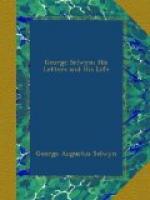You desired me to write to you often. You see, dear Lady Carlisle, toute l’inclination que j’y porte, et que, vraisem(bla)blement, si vous souhaitez d’avoir de mes lettres, une certaine provision de telles fadaises ne vous manquera pas. But I must hear myself from Caroline, or nothing will satisfy me; as yet I have not her direction, and so bad is my memory now, that this morning I could not even be sure if Stackpoole Court was near Milford Haven, Liverpool, or Milbourn Port. I do not comprehend how I could confound these three places, or be so depaise in regard to the geography of this island.
(260) Of Queensberry.
(261) Third daughter of the Earl of Carlisle, married W. Sloane Stanley, Esq.
(262) Marie Antoinette.
(263) Louis Philippe Joseph, Duc d’Orleans (1747-1793). As the Duc de Chartres he pretended to the philosophical opinions of the eighteenth century, but followed the dissolute customs of the Regency. Marie Antoinette never attempted to overcome or conceal her aversion to him, which helped to divide the Court. On the death of his father in 1785 he came into the title of the Duc d’Orleans. Interpolating the King at the famous royal sitting of the 19th of November, 1787, which he attended as a member of the Assembly of Notables, he was exiled to Villers Cotterets; in four months he returned and bought the good will of the journals by money and of the populace by buying up provisions and feeding them at public tables; he was nominated President of the National Assembly but refused the post; he attempted to corrupt the French guards, and so serious were the charges brought against him that La Fayette demanded of the King that he should be sent from the country. He went accordingly to England on a fictitious mission in October of 1789. He returned in eight months to be received with acclamation by the Jacobins, who were, however, themselves irritated at the coolness by which he voted for the death of his cousin, Louis XVI. in 1792; he was present at the execution, which he beheld unmoved, driving from the scene in a carriage drawn by six horses to spend the night in revelry at Raincy, but the title Egalite, which the Commune of Paris had authorised him to assume for himself and his descendants, did not save him from the same fate. The Convention ordered the arrest of all the members of the Bourbon family, and he was guillotined the 6th of November, 1793. The Duc de Chartres visited England in 1779 and was intimate with the Prince of Wales; on his return he introduced in France the English race meetings, jockeys, and dress. It was said that the Prince of Wales, on hearing of his conduct at the execution of the King, tore into pieces his portrait which he had left him.




